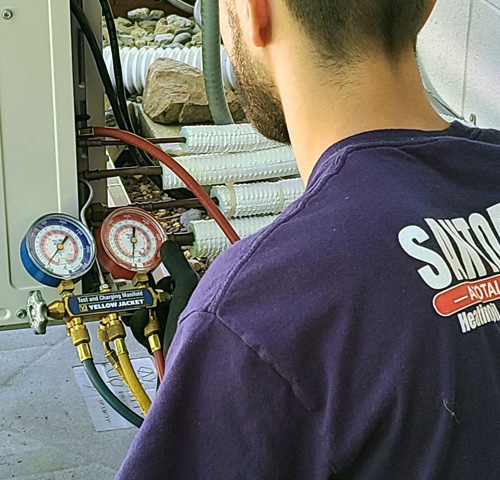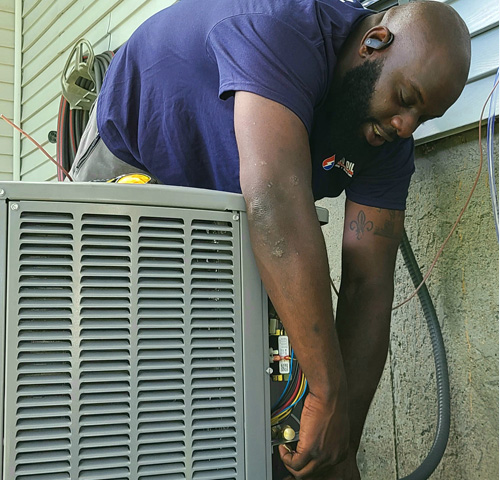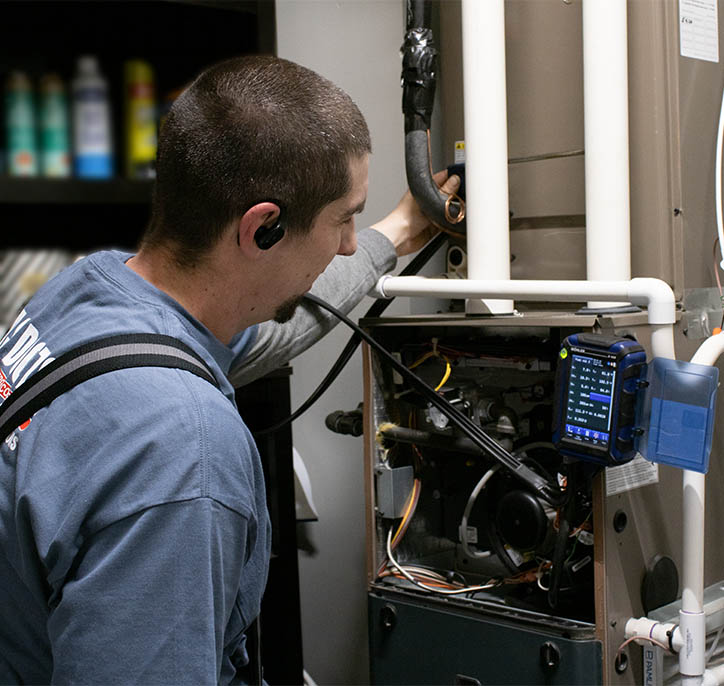RELIABLE SERVICE
FROM EXPERIENCED TECHS
UPGRADE YOUR EQUIPMENT
FOR EFFICIENCY & SAVINGS

ROUTINE SERVICE
Santoro's factory trained technicians are here to lend a hand when you need us
If you run into a problem with your heating or cooling equipment, give us a call. Our highly trained techs respond to service calls with knowledge and professionalism, taking the time to identify the problem and offer solutions that keep your equipment running at peak efficiency.


Air Conditioning Service
Servicing all major Central & Ductless Mini-Split Brands
Santoro Oil is proud to offer Air Conditioning service on all major brands of central and mini-split ductless air conditioners. We have fully licensed technicians that can service air conditioners from Armstrong Air, Bryant, Carrier, Heil, Fujitsu, Haier, Lennox, Rheem, York, Goodman, and much more. Air Conditioning service is provided to our oil and propane buying customers regardless of whether Santoro Oil installed the air conditioning system. Air conditioning service is conducted between 8:00 am and 4:00 pm.
What is involved in air conditioner service?
Central and mini-split air conditioners both have exterior and interior components that over time collect dust, dirt, and other debris. As part of our Air Conditioning service, we recommend having a tune-up performed on your cooling system. We perform the following during an Air Conditioning Tune-up for both Central Air Conditioners and Mini-Split Ductless Air Conditioners:
- Wash outside coil or condensing coil. This is found inside the casing of the central unit, most commonly seen as the main unit of central air conditioners. The mini-split unit has a small casing unit that is shorter and rectangular in shape.
- Clean indoor evaporator coil. The evaporator coil works with the indoor unit, found in both central and mini-split air conditioners to cool and condition indoor air that flows over it by extracting heat and moisture.
- Check and clean drains that flow from the exterior unit to the interior unit and back and in central air conditioning units drain out of the system properly to a drain pipe found near the unit. Keeping condensate drains cleaned prevents harmful contaminants like mold, mildew, and other bacteria from growing in the pipe.
- Check operation and electrical components to ensure that your cooling system is efficiently operating and will continue to work throughout the year.
- Check refrigeration and temperature readings to calibrate your cooling system to ensure that when it's hot outside your system keeps you cool inside.

Service Your Heating System
Yearly inspections ensure your equipment works when you need it
Santoro's routine maintenance on your boiler or furnace starts with a visual inspections of all the piping connected to the boiler and tank for corrosion and leaks. We look for any wet spots on or underneath the tank, check the condition of the tank legs, and look to ensure there are no visible oil leaks under the tank. Our techs will identify any potential hazards and discuss any recommended updates with you, since signs of corrosion are typically where proactive repairs can be made. We'll also use specialized equipment like a digital combustion analyzer to check all the critical functions of the heating system: Flue gas, CO2, Draft, pressure, ambient CO, etc.
Santoro's 16 Point Tune-Up for your Heating System
1. Brush and vacuum the heat exchanger, smoke pipe, and chimney base. Clean the area above and around the heating system.
2. Remove old oil filter cartridge, clean the filter bowl, flush the tank valve, and install a new filter cartridge and gaskets.
3. Check and flush fuel lines ensuring you get a constant flow of oil to the pump. Replace the pump gasket and strainer. Install a pressure gauge in the nozzle port and adjust the pump pressure to the manufacturer's specification.
4. Remove the old nozzle. Flush the jet line and nozzle assembly. Check the nozzle size for the proper firing rate. We use only the manufacturer's recommended nozzle with respect to firing rate, spray angle, and nozzle characteristics (hollow, solid, semi-solid, etc).
5. Examine the combustion chamber for cracks and irregularities which may cause difficulties in the performance of the heating systems as well as health hazards.
6. Check ignition: We carefully examine the electrodes and remove the porcelains from the holder which often hides hairline cracks. Check cable and bus bars or clip to make sure they are making contact. Check porcelains of the transformer for cracks, lint, or thin film of oil, which occasionally gets on areas and causes the circuit to ground out.
7. Check the air handling parts. Clean and adjust all parts for lint and grease. Remove the motor and clean the burner fan. At the same time inspect the coupling and replace it if necessary. Check to make sure the end cone is not burned off or shows signs of scorching.
8. Oil all motors; circulator, oil burner motor, and blower motor.
9. On units with power venters, make sure the proving tube and blower wheel are clean and lube the motor with the proper lubricant.
10. Check the CAD cells and relay for proper operation. On units with stack relays, clean the helix of soot and reinstall. Disconnect the motor circuit and test the relay for safety.
11. Steam systems: The boiler should be drained, flushed, and refilled to 3/4 full on the gauge glass. Gauge glass should be cleaned if dirty or replaced if needed. The low water cutoff should be flushed and tested. Remove the pressure control from the boiler and thoroughly clean out sediment that may have collected.
12. Hot water systems: Check the altitude gauge for pressure on the system, and also to make certain there is water at the highest radiator. IF there is an expansion tank, it should be drained. Examine air pressure thanks for waterlogging. Check the aquastat reading so that settings for hot water have a 30 degree differential between the circulator and the high limit. (Example: if the high limit is set for 200 degrees for boiler water, the reverse acting aquastat should be set no lower than 170 degrees for the circulator to cut in.
13. For warm air system: Check the heat exchanger for any visible cracks or holes. Check air filters and replace or clean them, depending on the type of filter. Check humidifier for proper operation. Replace media in accordance with the manufacturer's instructions. Check blower belts and adjust for proper tension.
14. Examine the position and setting of draft control.
15. Perform a complete combustion analysis and efficiency test procedure using a digital combustion analyzer.
16. We will leave the work area as tidy as we found it and provide a verbal report of the work performed, including any additional work that may be necessary for your heating system to run at peak performance.
Sign up for a Service Plan to save money & gain peace of mind
Service Plans offer yearly inspections, cleanings and adjustments to your oil burner and heating equipment to ensure that it's running at peak efficiency before the cold weather comes. Learn more about plans that are available by clicking the button below!


















